In the domestic critique of the Pohjanmaa-class, an often repeated claim is that with the Russian focus on light vessels, the few corvettes will simply be overwhelmed by the swarming vessels launching barrages of anti-ship missiles. Rarely however does anyone discuss this claim more in detail, including which small vessels would fire the barrages, whether the Russian fondness for light craft really exist, and what the geography in the Baltic Sea dictates. As it turns out, these oft-repeated truths aren’t necessarily truths at all.

Vladimir Putin inspecting the Baltic Fleet during Navy Day in Baltiysk last year. In the immediate background the flagship of the fleet, the destroyer Nastoychivyy. Source: Kremlin.ru via Wikimedia Commons
To begin with the geographic realities of the Baltic Fleet needs to be acknowledged. The main base, Baltiysk, sits in Kaliningrad. There it is not only within artillery distance from a NATO-country, but it also lacks a land connection to the Russian mainland, and any ship wanting to exit the port to reach the Baltic Sea has to do so by transiting the two kilometer long and 400 meter wide Strait of Baltiysk which cuts through the Vistula Spit. The second base is located in Kronstadt, just outside of St Petersburg. While the base is located closer to the Russian mainland and more easily defendable, it comes at cost of any vessel wanting to head over to the Baltic Sea proper having to run the full 400 km length of the 40 km wide Gulf of Finland. The Gulf of Finland is also shallow, making submarine operations with conventional submarines challenging. It is often forgotten in the Finnish discussions exactly how bad the geostrategic realities are for the Russian Baltic Fleet in the grand scheme of things.
The Russian Baltic Fleet feature a varied fleet, made up of a significant number of vessels of Cold War designs, including a single destroyer, frigates, light corvettes, and FACs. In addition, seven modern corvettes of three(!) different classes are found. If you are the kind of person who really want to pick the details and look into numbers, at the bottom is a somewhat lengthy go-through of the individual classes and their weapon systems.
In short, the majority of the Baltic Fleet is far from any kind of swarming wunderwaffe. The lightest vessels, the Molnaya, still displace almost twice that of the Hamina-class. The majority of the missiles carried by these vessels are old bordering on obsolete, though getting hit with a 300 kg warhead still hurts if the seeker works. As of writing, the Baltic Fleet operate seven modern vessels with any kind of surface warfare capability (and a single modern minesweeper of the Project 12700 Alexandrit-class), these being the four Steregushchiy, two Buyan-M, and single Karakurt corvettes. Notable is also that the endurance of the vessels are somewhat limited, usually around ten to fifteen days. As was seen during the fleet parades of 2018 reinforcements can come from the outside, though such movements risk alerting the adversary and the number of modern vessels in the Northern and Black Sea Fleets are limited as well.
A key point of the Russian fleet programmes is that the current focus is on frigates and corvettes, as opposed to swarming light vessels. However, it should be noted that this is also not due to a lack of interest in larger vessels. Many of the older destroyers and cruisers are undergoing long and difficult modernisation programs and overhauls, and there are longtime ambitions to launch new large surface combatants. However, the decade long gap in newbuilding has left its mark on the capability of Russia to build modern warships, making it hard to live up to these ambitions. Anders Puck Nielsen recently published an interesting study into the state of the Baltic Fleet, where he points out that the median age of ships above 300 tons in the Baltic Fleet is a full five years older than the average age of the same (29 compared to 24 years), clearly illustrating this split. Within the next five years it is likely that we will see the first new destroyers laid down, but considering the building time of frigates and the Ivan Gren-class LST, it will likely be more than a decade before these are operational. By that time Nastoychivyy will be approaching 40 years in service.
Through exercises such as the Northern Coasts and BALTOPS serieses, the Western navies ensure interoperability should the worst come.
In a conflict between NATO and Russia, the Baltic Fleet’s main mission would likely be sea denial. Especially the modern vessels are well-suited for the mission, though the poor basing options make them vulnerable. In a conflict between Finland and Russia, the Baltic Fleet’s base at Kaliningrad would on the other hand provide a safe haven 600 km from the Finnish coast, and the first step would likely be to regroup vessels from Kronstadt to the open waters in the northern parts of the Baltic Sea. However, with the Finnish Navy operating according to the policy that they know the identity of “all vessels passing close to our waters”, such a move would risk giving away the element of strategic surprise. Granted it is possible to mask fleet movements as an exercise, and/or to try and dash through the Gulf of Finland with the Kronstadt squadron in the immediate aftermath of a first strike, but achieving strategic surprise against an adversary that maintain a 24/7 readiness even with a limited number of vessels is hard.
In absolute numbers, the current Finnish Navy with eight FAC hiding in the archipelago backed up by significant coastal artillery assets, including truck-mounted anti-ship missiles, would be a tough enemy for the Russian fleet of about a dozen (mostly light) corvettes, six FAC, and a maximum of two heavier vessels. With the exception of the Kalibr-equipped vessels, the Russian vessels would have no range advantage, and in most cases would operate with significantly older vessels, weapons, and sensors. They would also be unable to rely on any kind of terrain masking, coming from the open sea. Their limited endurance would also mean that any kind of blockade or attempt at exercising sea control over the Archipelago Sea would require a rotating presence with squadrons taking turn on station, being in transit, and replenishing in Kaliningrad.
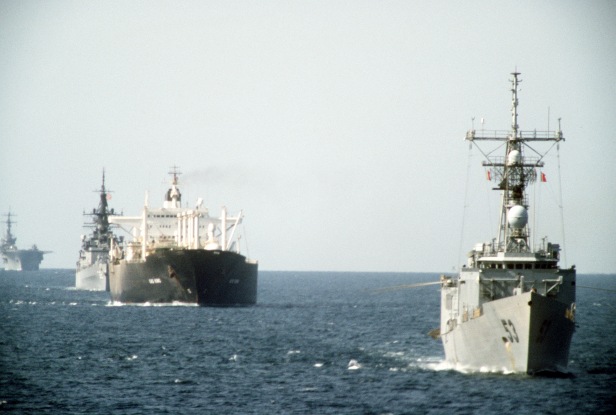
The best opportunity the Baltic Fleet would have is interdicting merchant shipping passing the open waters of the Sea of Åland as well as to a smaller extent Kihti (Skiftet) either by surface weapon or by mines laid by Dmitrov in suitable locations closer to shore. This would face the Finnish Navy with the choice of allowing the country to be under siege or coming out from the archipelago and taking up battle. This is a scenario for which the Pohjanmaa-class is well-suited, with the advanced sensor suite giving it superior situational awareness against the smaller and older Russian vessels, and with the endurance to stay at sea and choose the time and place of the battle. The Baltic Fleet is expected to grow in capability, both through new vessels such as the second Karakurt-class corvette Serpukhov as well as through modernisation programs, but through the introduction of PTO 2020, Hamina MLU, and the Pohjanmaa-class the relative power balance at sea is expected to remain roughly the same. Of the modernisation programmes, the most important is perhaps the replacement of the six P-120 Malakhit missiles on Project 12341 corvettes with up to sixteen Kh-35 Uragan. The first such modified vessel (of the Pacific Fleet) test-fired its missiles in February this year. However, it should be noted that while this would be a huge leap in capability for the Baltic Fleet, it is still just replacing a fifty year old missile with a twenty year old one.
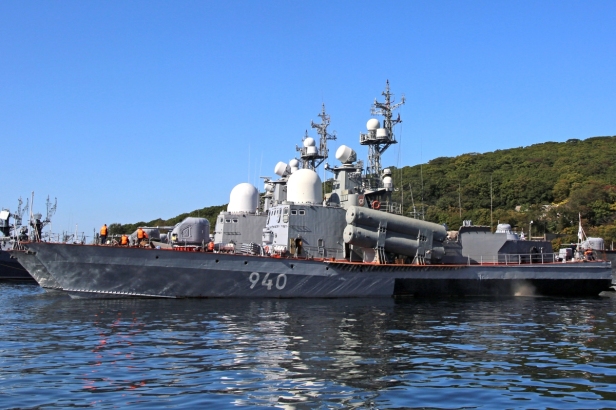
In the end, the Russian Baltic Fleet still is a serious adversary and should not be underestimated if the Finnish Navy ever was to face it alone. However, the maritime domain is still significantly more evenly matched than the air or land domains. There are some significant headaches, such as the possibility of Russia imposing a naval blockade on ships heading to Finland in the southern parts of the Baltic Sea or using submarines to lay mines to create a crisis below the treshold of war. The idea that Russia will be able to overpower the Finnish Navy by employing a vast number of light craft firing volleys of modern anti-ship missiles is however not backed up by the order of battle of the Baltic Fleet, nor by current or envisioned Russian shipbuilding programs.
The vessels of the Baltic Fleet
The flagship of the Baltic Fleet is the destroyer Nastoychivyy (‘610’), a Project 965A class destroyer (NATO-designation Sovremenny). The vessel was laid down as the Moskovskiy Komsomolets in 1987, and entered service in 1993. The vessel has a serious gun-battery in the form of two twin-130 mm gun turrets, as well as a number of 30 mm gatling AA-guns. The naval version of the Buk is also carried for air-defence. The weaker point of the vessel is the ASW-suite, which is mainly meant for self-defence (the Project 11551/Udaloy-II and 1155R/Udaloy were supposed to take care of that part). Mine rails are also found.
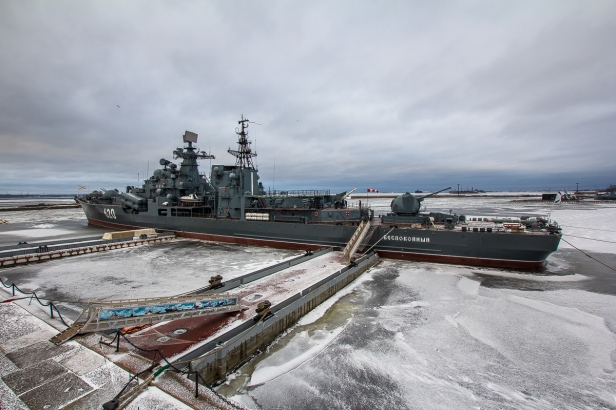
The main punch is provided by the twin quadruple launchers for the long-range P-270 Moskit or the even longer-ranged P-100 Moskit-M (SS-N-22 Sunburn) anti-ship missiles. The missile design dates back to the early/mid-1980’s, and the last missiles apparently rolled off the production lines in 1994. The missiles has a total weight of 3,950 kg, flies at Mach 2.5 and has a range of 100 km for the baseline-Moskit and 129 km for the Moskit-M, of which “only a few were made” according to USNI. The missiles use an active radar seeker, and carries a 300 kg warhead (of which half the weight is made up off the explosives). An interesting detail is that the design was sold to Boeing, for use as target drones.
Nastoychivyy is currently undergoing overhauls, including a renewal of the propulsion system. This is based on two sets of geared steam turbines driving two propeller shafts. However, naval propulsion is a big headache throughout Russia, as they went to war with the country producing their (relatively) modern gas turbines, while at the same time are having serious trouble in producing modern high-powered diesel engines suitable for naval use. It remains to be seen if and when the Nastoychivyy will get moving again.
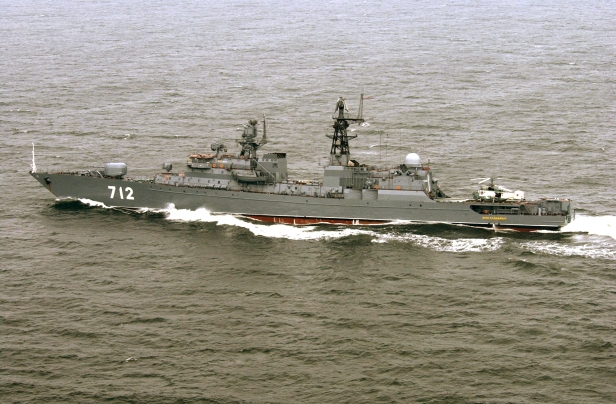
Another large vessel of the Baltic Fleet from the same era is the frigate Yaroslav Mudry (‘777’), second and final vessel of the Neustrashimyy-class (Project 11540). Mudry had the bad luck of getting stuck in the turbulence following the fall of the Soviet Union, and took 21 years from being laid down in 1988 until she actually entered service in 2009. The design is optimised for ASW-duty, including through carrying a Ka-27 ASW-helicopter, and the combat system sports the distinction of being the first fully integrated computerised system in use by the Russian Navy. Yaroslav Mudry has done a number of long voyages, and just recently passed through the English Channel heading south. Sister and leadship of the class Nesutrashimyy (‘712’) is currently in the final stages of a five year overhaul. These repairs saw a serious fire, and at times the sleek vessel looked like it might never get back to sea. However, reports are now stating that she will be able to join the Baltic Fleet before the end of the year.
In the anti-ship role, the Neustrashimyy-class can carry up to sixteen Kh-35 Uran (SS-N-25 Switchblade) anti-ship missiles in four quadruple launchers, though the usual complement is half that number. The Kh-35 reminds more of typical western designs, carrying a 145 kg warhead at high-subsonic speeds and with a range of up to 130 km. The radar seeker is able to operate in both active and passive modes, and the weapon entered service in the late 90’s.
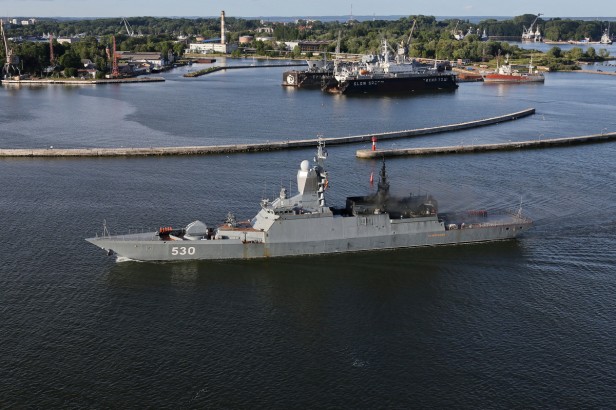
Significantly more modern vessels are found in the form of the four Steregushchiy-class (Project 20380) multi-purpose corvettes. Carrying up to eight Kh-35 Uran, the most impressive feature is still the Redut-air defence system. Redut is a VLS-system related to the S-400-family, and reportedly uses three different missiles with 15 km/40 km/120 km max range respectively. The system is reported to receive a new longer-ranged missile with ABM-capability in the near future, and integration with the new Poliment-radar is reportedly operational since the first half of the year. The Steregushchiy is however far from a one-trick-pony, and also feature a serious ASW-capability. The class is roughly comparable to the Pohjanmaa-class, being about 105 meters long, with a shallow draft and a top speed somewhere in the order of 27 to 30 knots. The big difference is the lack of the dedicated mine hull of the Pohjanmaa, and the significantly lighter full load displacement of 2,100 ton.

Moving down the ladder in size, the most modern vessels of the Russian Baltic Fleet are the two Buyan-M (Project 21631) and upcoming Karakurt (Project 22800) corvettes. The Buyan-M corvettes Zeleny Dol (‘562’) and Serpukhov (‘563’) entered the Baltic Sea in 2016, and caused quite a stir due to their VLS being able to handle up to eight Kalibr-cruise or anti-ship missiles. The range of the 3M-14 cruise missile version of the Kalibr allow the vessels to strike targets anywhere in the greater Baltic Sea region, while the 3M-54 anti-ship version is charachterised by its very high speed in the final attack run, reaching up to 3.0 Mach. However, the vessels are in certain aspects closer to large FAC than corvettes, as they completely lack ASW-capability and have a very limited anti-air capability featuring 30 mm CIWS and a single short-range Gibka-launcher firing navalised versions of the late-80’s era Strela-3.
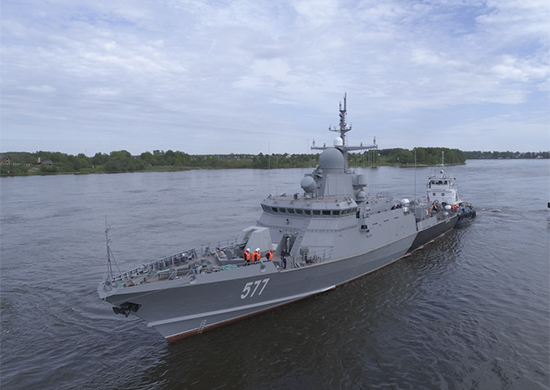
For the Karakurt-class, the first vessel Mystischi (‘567’) was declared operational during late 2019, with a number of sisters expected to follow the vessel into service in the Baltic Sea. However, the build rate has been delayed due to lack of suitable M507 diesels. Compared to the Buyan-M, the Karakurt feature the same eight-cell VLS for Kalibr-missiles, but employs the moder modern short-range navalised Pantsir-M system instead of the Gibka. The endurance is also longer, at fifteen days compared to ten days for the Buyan-M. A more in-depth comparison is found here. The main gun has also gone down in calibre from 100 mm on the Buyan-M to 76.2 mm on the Karakurt.
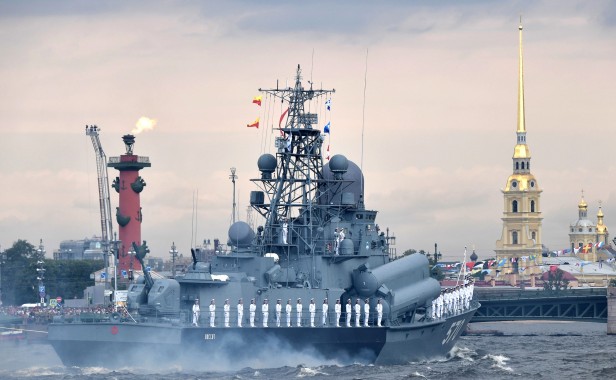
The last surface vessels with a serious anti-surface capability are all Soviet-era designs. Four Project 12341 (Nanuchka III) class corvettes date to the last years of the Soviet Union, and carry six P-120 Malakhit (SS-N-9 Siren) heavy anti-ship missiles. The missiles have a rather limited range of 56 km unless they are assisted by a forward observer and flies at high subsonic speed. In addition the vessels have a short-range SAM-system in the form of the Osa-M, a 76.2 mm deck gun, and one of the ubiqous 30 mm gatling CIWS. The vessels sport a ten day endurance. The smaller FACs are represented by two Project 12411T Molnaya (Tarantul II) and four of the sligthly newer Project 12411 Molnaya-M (Tarantul III). In this case ‘newer’ means of the same age as the 12341s, as opposed to the original Monayas which both date to the first half of the 80’s. The Molnaya feature four of the outdated P-15M Termit (SS-N-2C Styx), while the Molnaya-M have four of the P-270 Moskit that are also carried by the Nastoychivyy. Both classes employ a 76.2 mm deck gun, Strela-3 short-range SAM launchers, and single-barreled 30 mm CIWS systems. Both classes share the 10 day endurance with the larger Project 12341. The vessels have been in and out of dry dock during 2019, but apparently none of them have undergone any larger upgrades for the time being.
The final vessel that would play a key part in any naval battle is the sole submarine of the fleet, the B-806 Dmitrov. Dmitrov is a Project 877EKM (Kilo) class submarine, and was laid down in 1985 and entered service two years later. The Dmitrov was refitted in St Petersburg during 2001 and 2002, and has often been used to train foreign crews for export Project 877s. With a 45 day endurance the submarine can not only carry up to 18 torpedoes, but also up to 24 mines, or a mix of the two. The sligthly older B-227 Vyborg has recently been retired.
The rest of the Baltic Fleet is made up of landing crafts, amphibious vessels, single-role mine warfare and ASW-vessels, as well as auxilliaries. In addition a number of ground and air units sort under the fleet.


I kind of think that one of the bigger issues for the Baltic Fleet is the lack of modern ASW capable ships. NATO countries in the region, together with sweden, have a sizable submarine force. Though the Baltic Sea is shallow, it is also very layered, which makes detection of submarines fairly difficult. Having submarines, supported by smaller and cheaper ASuW ships and aircraft against Russia really tips the scales heavily in NATO’s favour.
Focusing too much on ASuW might end up hurting Russian forces quite badly. Another nail in the coffin would be the lack of minesweepers/-hunters. Minelaying is surely the next logical direction that the Baltic countries are going to take. Add Finland and Poland to that mix and things start looking even more dire.
This very detailed overview, for some reason, utterly omits the on-shore forces of the RUS Baltic fleet. There are missiles with considerable reach there, that may quite successfully place the AA/AD for the Baltic states. Also conventional long-range artillery had a good practice run near Ukraine’s Eastern borders. No attention was also payed to naval air force. Is it really so non-existent? The EW capabilities of the planes and ships, even with short term action, can cause havoc for the air traffic. No reference to that either. Baltic fleet is not only seagoing ships. It’s so much more.
As I note in the ingress, the post is written in answer to a particular point of critique that I find unfounded. As such major capabilities of the Baltic Fleet are left outside of the discussion, including not only the coastal defence units (which play a very minor role from a Finnish point of view) and the air arm, but also e.g. the minesweeping vessels and the amphibious assault capabilities (including marine infantry).